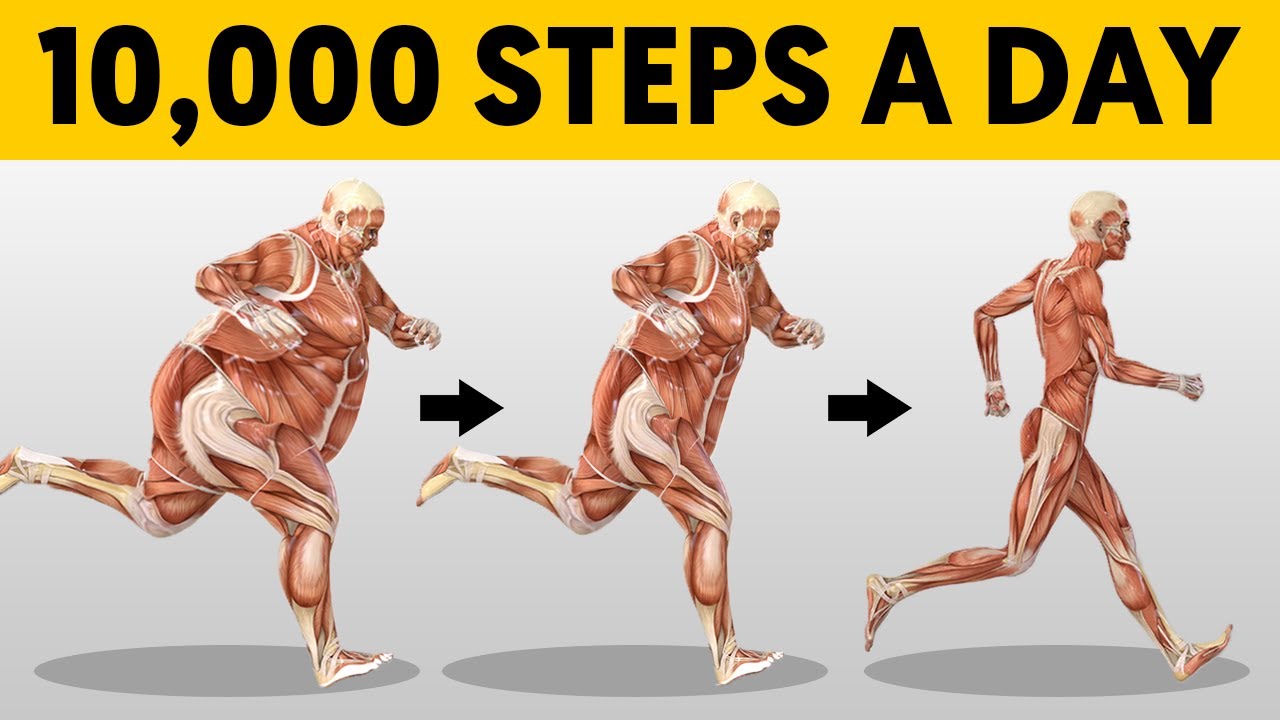What 10,000 Steps a Day Does To Your Body
Health experts recommend walking 10,000 steps a day as a great level of activity for adults.
Did you know that 10,000 steps are equal to 8 kilometers, or an hour and 40 minutes of walking, depending on your walking speed and stride length?
Seems overwhelming?
Of course, you don’t need to do all steps in one walk.
You can accumulate steps by doing your day-to-day activities.
However, to achieve a 10,000 goal, you may need to at least walk for 30 minutes.
But how does this affect the body?
You can expect tons of benefits from regular physical activity (e.g., better heart health and stronger lungs), which we will be discussing more next.
To know more about these benefits, continue watching this video.
Improves heart health
Frequent walks help keep heart-related diseases and conditions at bay, including diabetes, and high cholesterol.
If you get 10,000 steps a day, you have a bigger stroke volume, meaning you have a greater aerobic capacity.
This is a good indication that you have a lesser risk of getting heart diseases.
Strengthens lungs
Moving every day helps strengthen your lungs and its surrounding muscles.
Whenever the volume and rate of oxygen you exhale increases, so does your body’s ability to use it efficiently.
In other words, the more fit you are, the better this certain body function performs.
Improves focus
Walking 10,000 steps a day compels your body to release feel-good hormones.
Additionally, it boosts blood flow to the brain, resulting in improved cognitive function.
Thus, not only do you feel less stressed when you regularly exercise, but you’re also working on boosting your focus and productivity.
Strengthens bones
Walking is a weight-bearing exercise.
According to studies, this type of exercise puts extra pressure on your bones, helping them improve their density and gain strength.
In the long run, this helps reduce the risk of osteoporosis.
Plus, walking is easy on the joints, so it’s perfect for those whose condition makes it hard to exercise.
Stabilises blood sugar
Researches revealed that people who get 10,000 steps a day have significantly lower glucose and insulin response in their blood after a meal.
Meanwhile, inactive people have a much bigger response.
This surge of insulin and glucose after every meal is an indication of who will have diabetes down the road, as well as cardiovascular disease.
Boosts flexibility
Physical activity even as simple as walking can improve your flexibility.
In turn, it improves your posture, reduces pains and aches, and reduces the risk of injury.
Reduces body fat
Burning fat is one of the biggest priorities of many people today.
Excess body fat is mostly due to the lack of exercise or movement.
Luckily, you don’t have to resort to vigorous workouts to lose weight.
Aiming for 10,000 steps a day can help you.
This may not give you the dream body you want, but it’s a good start.
Tones your stomach, butt, and legs
Walking can also help you tone up.
Adding new elements and locations to your walking routine can lead to results that you once thought can only be achieved through intense workout plans.
For instance, you can opt to walk uphill or use a place that has stairs.
This will increase muscle movement and engagement, enhancing the results.
So, are you up for this 10,000 steps a day challenge?
Comment your answer below!



![[ID: Hx_A0iLhdr8] Youtube Automatic](https://bizimtube.com/wp-content/uploads/2021/03/id-hxa0ilhdr8-youtube-automatic-236x133.jpg)
![[ID: lp7w0UmpuIs] Youtube Automatic](https://bizimtube.com/wp-content/uploads/2021/03/id-lp7w0umpuis-youtube-automatic-236x133.jpg)
![[ID: s2-7T1TH-lY] Youtube Automatic](https://bizimtube.com/wp-content/uploads/2021/03/id-s2-7t1th-ly-youtube-automatic-236x133.jpg)
![[ID: b_lakC9M4UQ] Youtube Automatic](https://bizimtube.com/wp-content/uploads/2021/03/id-blakc9m4uq-youtube-automatic-236x133.jpg)
![[ID: r44yl6nPONs] Youtube Automatic](https://bizimtube.com/wp-content/uploads/2021/03/id-r44yl6npons-youtube-automatic-236x133.jpg)
![[ID: pAwto1YQjA8] Youtube Automatic](https://bizimtube.com/wp-content/uploads/2021/03/id-pawto1yqja8-youtube-automatic-236x133.jpg)
![[ID: XETG8azHiv4] Youtube Automatic](https://bizimtube.com/wp-content/uploads/2021/03/id-xetg8azhiv4-youtube-automatic-236x133.jpg)
![[ID: f3G_-S_2HUk] Youtube Automatic](https://bizimtube.com/wp-content/uploads/2021/03/id-f3g-s2huk-youtube-automatic-236x133.jpg)
![[ID: G8oWns54snA] Youtube Automatic](https://bizimtube.com/wp-content/uploads/2021/03/id-g8owns54sna-youtube-automatic-236x133.jpg)
![[ID: s0lIFXhu6aw] Youtube Automatic](https://bizimtube.com/wp-content/uploads/2021/03/id-s0lifxhu6aw-youtube-automatic-236x133.jpg)
![[ID: 4UTd2Ev8eYg] Youtube Automatic](https://bizimtube.com/wp-content/uploads/2021/03/id-4utd2ev8eyg-youtube-automatic-236x133.jpg)
![[ID: RKBGBjVJBxQ] Youtube Automatic](https://bizimtube.com/wp-content/uploads/2021/03/id-rkbgbjvjbxq-youtube-automatic-236x133.jpg)